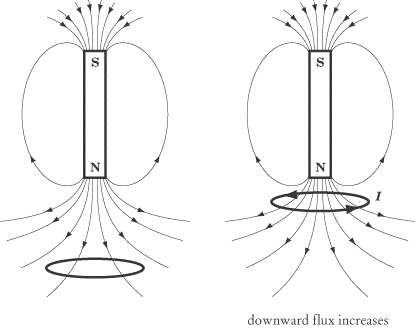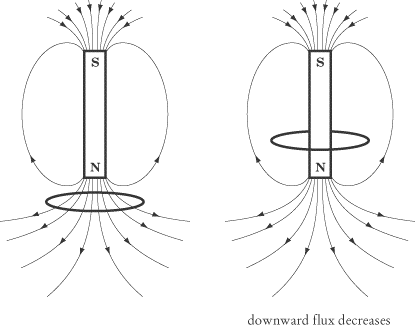
The unit of flux is the weber (Wb), where 1
Wb = 1 T · m2.
Changing Magnetic Flux
As we will see shortly, dfis more important than f:
our interest is in how flux changes, not in its fixed value. The formula for
magnetic flux suggests that there are three ways of changing magnetic flux:
- Change the magnetic field strength: By sliding a permanent magnet back
and forth, the magnetic field in a certain area will fluctuate. We will look at
this phenomenon a bit later in this chapter.
- Change the area: When a bar slides on rails in a magnetic field, as in
our discussion of motional emf, the square bounded by the bar and the rails gets
larger. As it grows, the number of field lines passing through it increases, and
thus the flux increases as the bar moves.
- Rotate the area, changing the angle between the area and the magnetic field:
When the area is perpendicular to the magnetic field, the magnetic flux will
simply be the product of the magnitudes of the area and the magnetic field
strength. However, as you rotate the area so that it is at an angle to the
magnetic field, fewer field lines will pass through it, and so the magnetic flux
will decrease.
Example

A square with sides of length 2 m is perpendicular to a magnetic field of
strength 10 T. If the square is rotated by 60º, what is the change in magnetic
flux through the square?
First, let’s calculate the flux through the square before it’s rotated. Because
it’s perpendicular to the magnetic field, the flux is simply the product of the
area of the square and the magnetic field strength:
fi = BA = (10T)(4m2) = 40Wb
Next, let’s calculate the flux through the square after it’s rotated. Now we
have to take into account the fact that the square is at an angle of
60º:
fƒ= BA cos 60 = (10T)(4m2) = (0.5) = 20 Wb
So the change in magnetic flux is :
fƒ fi = 20 Wb - 40 Wb = 20 Wb
The magnetic flux decreases because, as the square is rotated, fewer magnetic
field lines can pass through it.
Faraday’s Law
We have seen earlier that a bar sliding along rails is a source of induced emf.
We have also seen that it is a source of changing magnetic flux: as it moves, it
changes the area bounded by the bar and the rails. The English scientist Michael
Faraday discovered that this is no coincidence: induced emf is a measure of the
change in magnetic flux over time.

This formula is called Faraday’s Law.
Equivalence of Faraday’s Law with E = vBl
The earlier example of a metal bar rolling along tracks to induce a current is
just a particular case of the more general Faraday’s Law. If the bar is moving
at a constant velocity v, at
which it covers a distance
?x
in a time
?t,
then:

Because
?(xl)
is the same thing as
?A,
we get:

Lenz’s Law
Faraday’s Law tells us that a change in magnetic flux induces a current in a
loop of conducting material. However, it doesn’t tell us in what direction that
current flows. According to Lenz’s Law, the current flows so that it
opposes the change in magnetic flux by creating its own magnetic field. Using
the right-hand rule, we point our thumb in the opposite direction of the change
in magnetic flux, and the direction in which our fingers wrap into a fist
indicates the direction in which current flows.
Lenz’s Law is included in Faraday’s Law by introducing a minus sign:

Example
The square in the previous example, with sides of length 2 m and in a magnetic
field of strength 10 T, is rotated by 60º in the course of 4 s. What is the
induced emf in the square? In what direction does the current flow?
We established in the previous example that the change in flux as the square is
rotated is –20 Wb. Knowing that it takes
4 seconds to rotate the square, we can
calculate the induced emf using Lenz’s Law:

As for determining the direction of the current, we first need to determine the
direction of the change in magnetic flux. From the diagram we saw in the
previous example, we see that the magnetic field lines,
B, move in the upward
direction. Because we rotated the square so that it is no longer perpendicular
to the field lines, we decreased the magnetic flux. Saying that the magnetic
flux changed by –20
Wb is equivalent to saying that the flux
changed by 20
Wb in the downward direction.
The direction of the current must be such that it opposes the downward change in
flux. In other words, the current must have an “upward” direction. Point the
thumb of your right hand upward and wrap your fingers into a fist, and you will
find that they curl in a counterclockwise direction. This is the direction of
the current flow.
Conservation of Energy
Lenz’s Law is really a special case of the conservation of energy. Consider
again the bar sliding on rails. What would happen if the induced current did not
oppose the change in flux?
Since the current flows counterclockwise, the current in the bar flows toward
the top of the page. Thus, the magnetic field exerts a leftward force on the
bar, opposing the external force driving it to the right. If the current flowed
in the other direction, the force on the bar would be to the right. The bar
would accelerate, increasing in speed and kinetic energy, without any input of
external energy. Energy would not be conserved, and we know this cannot happen.
Changing the Flux by Changing the Magnetic Field
So far, we have changed the magnetic flux in two ways: by increasing the size of
the circuit and by rotating the circuit in a constant magnetic field. A third
way is to keep the circuit still and change the field. If a permanent magnet
moves toward a loop of wire, the magnetic field at the loop changes.

Remember that field lines come out of the north (N) pole of a magnet. As
the magnet moves closer to the loop, the flux in the downward direction
increases. By Lenz’s Law, the current must then be in the upward direction.
Using the right-hand rule, we find that the current will flow counterclockwise
as viewed from above.
As the middle of the magnet passes through the loop, the flux decreases in the
downward direction. A decrease in the magnitude of the downward flux is the same
as a change in flux in the upward direction, so at this point the change in flux
is upward, and the current will change direction and flow clockwise.

It doesn’t matter whether the magnet or the loop is moving, so long as one is
moving relative to the other.
Back
Next
Next to display next topic in the chapter.
Practice Questions
Video Lessons and 10 Fully Explained Grand Tests
Large number of solved practice MCQ with explanations. Video Lessons and 10 Fully explained Grand/Full Tests.